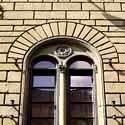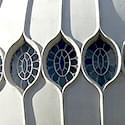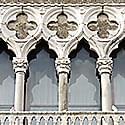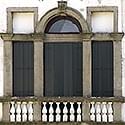
venetian arch, a round–headed opening containing two semi–circular–headed lights separated by a colonnette, with a roundel located in the space above.

venetian blind, an internal or external (rare) sun–blind consisting of adjustable horizontal slats that can be raised or lowered as required.
The origin of this artefact is uncertain, but it is certainly not from Venice, even though the Italians use the term tenda veneziana (‘Venetian curtain’). Other countries use the French term, or a variation on it, ‘jalousies à la persiennes’, suggesting Persia as the country of origin of the jalousies, or screens. Attempts have been made to relate the Venetian blind to Egypt, China, or Japan. Slatted screens, fixed or moveable, will almost certainly have developed simultaneously in countries far apart from each other. The need for shade combined with air movement is greatest in hot countries. Italian housewives, for instance, know in detail how best to operate all the internal and external slatted shutters throughout the day to achieve maximum comfort. In temperate climates the need is less and the provision therefore more fundamental; as a result, the mode of operation is less well understood. The German architect Hermann Muthesius wrote in The English House (1904) ‘the Venetian blinds we like so much are seldom seen in England’. In spite of the fact that Venetian blinds had been introduced into England in the eighteenth century the English still struggle to operate them. Adjusting the angle of the slats and raising the blind generally presents no problem; to lower the blind the cord must be pulled sideways, away from the jamb, at an angle of about 5° and parallel with the plane of the window in order to release the catch that holds the blind up.

verandah, veranda, a lightly constructed open–roofed area commonly found in association with French windows.
Scholars have come to blows over the derivation of this word. The Oxford English Dictionary says ‘That the word as used in England and France was brought by the English from India need not be doubted. But either in the same sense, or in one closely analogous, it appears to have existed, quite independently, in Portuguese and Spanish . . .’. As a shading or cooling device the verandah has its limitations, and English in India were quick to call into aid an evaporative cooling machine, the newly invented thermantidote (under which heading see the experiences of Fanny Parkes). The merits of the verandah in hot countries will be clear — shading, covered external circulation, and sheltered open–air living; but in more temperate climates these benefits are not so easily realised. A solid roof will shade the windows and thereby keep the rooms cooler in summer, but at other times, inevitably, also darker. A compromise is sometimes reached in which glazed areas are introduced directly over windows, as seen in this English example.

vesica piscis, a pointed oval shape often found in windows [Latin: vesica, a bladder or blister; piscis, a fish].
The Oxford English Dictionary tells us that the reason for the name is disputed, and that the term is derived from the fish–like shape of an inflated bladder, rather than the bladder of a fish. The figure is usually described as parts of two equal circles passing through each other at their centres. The shape of the windows shown in the illustration might be described as a vesica piscis with ogee terminations.
Vitrolite, a tough coloured or translucent glass developed around 1930 and often used as external cladding.
Vitruvian opening, see Egyptian window.





